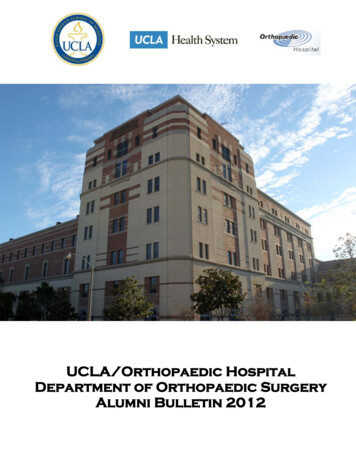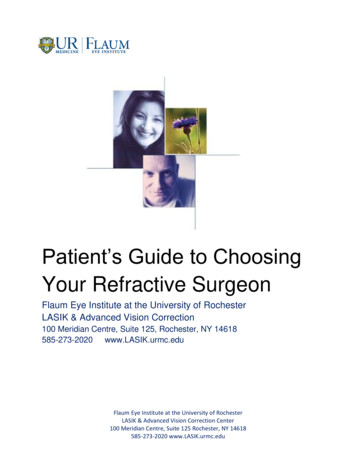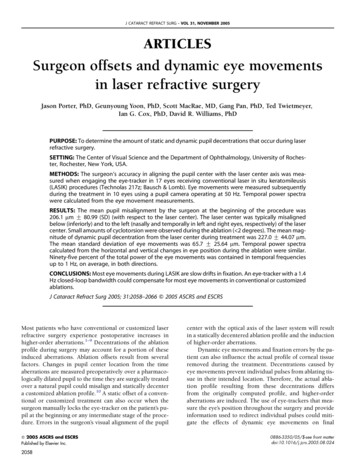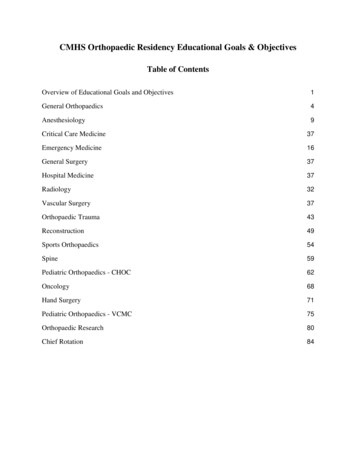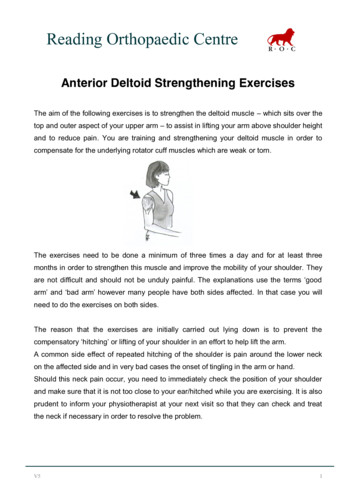
Transcription
Reading Orthopaedic CentreAnterior Deltoid Strengthening ExercisesThe aim of the following exercises is to strengthen the deltoid muscle – which sits over thetop and outer aspect of your upper arm – to assist in lifting your arm above shoulder heightand to reduce pain. You are training and strengthening your deltoid muscle in order tocompensate for the underlying rotator cuff muscles which are weak or torn.The exercises need to be done a minimum of three times a day and for at least threemonths in order to strengthen this muscle and improve the mobility of your shoulder. Theyare not difficult and should not be unduly painful. The explanations use the terms ‘goodarm’ and ‘bad arm’ however many people have both sides affected. In that case you willneed to do the exercises on both sides.The reason that the exercises are initially carried out lying down is to prevent thecompensatory ‘hitching’ or lifting of your shoulder in an effort to help lift the arm.A common side effect of repeated hitching of the shoulder is pain around the lower neckon the affected side and in very bad cases the onset of tingling in the arm or hand.Should this neck pain occur, you need to immediately check the position of your shoulderand make sure that it is not too close to your ear/hitched while you are exercising. It is alsoprudent to inform your physiotherapist at your next visit so that they can check and treatthe neck if necessary in order to resolve the problem.V51
Anterior Deltoid Strengthening ExercisesMay 20101. Pendulum exercises – standing and leaning forwards, supporting yourself with yourgood arm, let the bad arm swing like a pendulum. It can swing forwards, backwards,side to side and in a circular motion for up to 5 minutes. This exercise is also useful torelax the muscles after you have carried out the other exercises.2. Lying on your back – lift the bad arm to a vertical position with the help of your otherarm. Then hold the bad arm in the vertical position with its own strength for as long asyou are able while also keeping the elbow straight. Bring the bad arm back down toyour side with the help of the other arm. As your arm gets stronger, you will be able tolower it to your side without help. When this becomes easy move to exercise 3. V52
Anterior Deltoid Strengthening ExercisesMay 20103. Lying on your back – as the vertical position becomes easier to maintain, the exercisecan be progressed. With the elbow straight, start to move your arm forwards andbackwards. Try to keep the arm moving in a slow, smooth, straight line and keep itlined up with the side of your body. As your control and confidence improves begin toincrease the range of motion until the arm can move from the side of your body totouching the bed above your head and backagain.Continue this movement for up to 5 minutes or until your arm fatigues.When this becomes easy move to exercise 4.V53
Anterior Deltoid Strengthening Exercises4.May 2010Lying on your back – the next progression is to add a small weight e.g. a tin ofbeans, small bottle of water. Hold this in the hand of your bad arm andcontinue to move the arm from your side to above your head and back againin a smooth movement for up to 5 minutes or until the arm fatigues.V54
Anterior Deltoid Strengthening ExercisesMay 20105. Use a piece of stretchy elastic which your physiotherapist can provide. Tie a big knot atone end, loop it over the top of a door and then close the door.Now stand or sit sideways with the bad side closest to the door. Reach as far upthe band as you can with the hand of the bad side. You can use your good arm tohelp the bad arm to reach higher or it may help if you initially pull the band downwith the good arm and then hold on to it with the bad arm.The exercise involves pulling the band down as far as you can and then slowlycontrol the release or upward movement of the band back to the starting position.Repeat this movement for as long as you can control it.V55
Anterior Deltoid Strengthening ExercisesMay 20106. Standing facing the wall holding a cloth or duster against a smooth bare bit of wall ordoor.Slide your hand up the wall as far as you can and, if necessary, push the handfurther up the wall with the good arm. Now allow the bad side hand to slide backdown the wall but keep the movement slow and controlled. Repeat this exercisefor as long as you can control the movement.V56
Anterior Deltoid Strengthening ExercisesMay 20107. Once exercise 4 becomes easier to carry out, you can alter the startingposition of the exercise by gradually moving from lying on your back tositting and then to standing. As you begin to sit up, stop using the smallweight and start again with just holding the arm in the uprightposition before carrying out the backwards and forwards movement. Yourarm will automatically feel heavier because of the effect of gravity. As theexercise becomes easier again, you can use the weight.If you are having difficulty raising your arm in the reclined or sittingposition you can use your good arm to help lift the bad side and then lower it backdown under its own strength.V57
Anterior Deltoid Strengthening ExercisesMay 2010Contact detailsContact detailsNHSMr Brownlow’s secretaryDepartment of OrthopaedicsRoyal Berkshire HospitalLondon RoadReadingBerkshire RG1 5ANPrivateMr Brownlow’s secretarySpire Dunedin HospitalBath RoadReadingBerkshireRG1 6NSTel: 0118 322 8191Fax: 0118 322 8908www.royalberkshire.nhs.ukSecretary: 0118 971 0519Hospital: 0118 922 6888www.readingorthopaediccentre.comUseful er/rotator-cuff-tears.htmlThis information sheet is not a substitute for professional medical care and should be usedin association with treatment at your hospital. Individual variations requiring specificinstructions not mentioned here might be required. It was compiled by Catherine Anderson(Specialist Physiotherapist) and Mr Harry Brownlow (Consultant Orthopaedic Surgeon)and was illustrated by Jill Gillespie (Specialist Physiotherapist).V58
Department of Orthopaedics Spire Dunedin Hospital Royal Berkshire Hospital Bath Road London Road Reading Reading Berkshire Berkshire RG1 5AN RG1 6NS Tel: 0118 322 8191 Secretary: 0118 971 0519 Fax: 0118 322 8908 Hospital: 0118 922 6888
